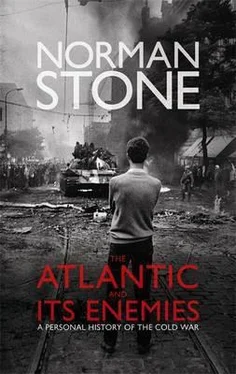It had quite long origins: even in the 1830s, Stendhal, for instance, has throw-away and dismissive lines about American business and dollar worship, and the Teamsters, a famous union mainly on the docks, took their name from the mule-drivers of yore. In the 1850s Sam Colt was able to assemble a first-class gun in thousands, because he made each part the same, to within a thirty-second of an inch to start with, and then a five-hundredth, so that they were interchangeable, and Linus Yale, of locks fame, goes back to that period. Machines were soon made with interchangeable parts, and the tools that produced these became an American specialty, keeping British war industries going in both of the world wars. Henry Ford famously transferred this to motor cars that were therefore cheap. Various explanations have been offered: unskilled immigrant labour, needing to be given simple and repetitive tasks within their capacity; expensive labour, putting pressure on firms to diminish their costs by use of machinery; practical education, such as was plentifully on offer; the peculiarly classless atmosphere in the USA, where ordinary workmen would co-operate on friendly terms with an owner when it came to reporting faults and taking an interest in machines, whereas elsewhere workmen regarded them as an enemy and in Britain were notoriously reluctant to accept them, because they would be tended by fewer workmen and might depress wage rates. In the Marshall years British trade unionists went to the USA to learn about productivity and the results were generally depressing. But the essential seems to have been the quality of management.
In Europe at large this was misunderstood, because of business schools; and it was a curious fact that they did more damage than good. Any true businessman regarded them as pernicious or at least useless: Sir James Goldsmith remarked, for instance, that he would never hire anyone for senior management who had failed to leave school at sixteen. One trouble was that those who could not manage, taught, and sometimes preached. Real managers have better things to do, and asking them about theories of management is equivalent to asking a first-class golfer to lecture on ballistics. There was even around 1900 a group of men who wanted to make business academically respectable and Harvard acquired a business school that its founders expected to rival the law school. Frederick Winslow Taylor (1856-1915) invented the time-and-motion study, in which white-coated experts studied the performance of the workforce, and, with slide-rules, criticized. Early on, the application of these methods caused demoralization and in the Ford plant at Dearborn turnover of the workforce stood at 900 per cent a year. Taylor’s claim was to ‘mathematize’ everything, and though himself a failure as a manager of men, he was the ancestor of the management consultant, and even the originator of a notion that management could be learned from books as distinct from experience. He and later followers referred to their creed as ‘Scientific Management’, and this suited some modern production methods, by ‘flow’, i.e. of workers each, on a slowly moving belt, assembling one part and moving it on to another worker who would add something to it. To manage men doing this mechanical stuff was not at all easy: in fact Taylor himself once remarked that he preferred a ‘little Dutchman’ for a pig-iron job because what it needed was ‘the mental make-up’ of an ‘ox’. In the USSR later on, ‘Taylorism’ was thought to be a good doctrine to follow. As things turned out, it was not, because it was so machine-like and inhuman. One reason for the failure of the USSR in the end was that it copied what it thought to be the most successful, because nastiest, method of managing labour. It merely demoralized, and created drunks.
America’s businessmen managed in fact in different ways and in the fifties they were very successful. One striking aspect was the in-house research laboratory. The Dupont Company, the first of America’s great ones, already employed a hundred technicians in gleaming new buildings, and the example was followed by General Electric, where a mathematical genius tinkered away at Schenectady in New York State, and helped produce the cathode tube and the high-frequency alternator which made commercial broadcasting possible. General Electric then set up the National Broadcasting Corporation. Bell Laboratories was the research side of AT&T and it produced sixteen Nobel Prizes over the half-century: even the theory of information technology came from there, with a paper in 1948 called ‘A Mathematical Theory of Communications’, by Claude Elwood Shannon (like other mathematicians a considerable eccentric, who rode along the corridors on a specially made bicycle which enabled him along the way to juggle balls). As Kenneth and William Hopper say, these vastly successful companies ‘achieved a delicate… balance between… share-holders, employees, managers, suppliers, customers — and researchers’. They also attracted young scientists, who somehow gave of their best, because they were well-led, by men with knowledge and enthusiasm. Productivity growth per man-hour was 3 per cent per annum in the fifties and sixties, an extraordinary and unmatched figure.
Alfred Chandler analysed the success story — two men at the top, one a chairman, complementing each other; both, products of the business itself, and sometimes with a very lowly start in it; a readiness for long-term thinking rather than short-term profits. A rule was ‘one man, one boss’; employees would be given as good a guarantee as possible of long-term work: the middle manager was seen as the ‘keystone of the managerial arch’ because, through him, information could be collected and passed up. The great companies survived the 1930s because they had carefully avoided debt; they were able to shift resources towards the new products that distinguished that decade, despite the general blackness: radio, telephones, commercial aircraft, electrical goods. The Slump stimulated them as slumps are meant to do — ‘the only cause of prosperity is depression,’ said the economist Clement Juglar, a student of the business cycle. They cut costs and made intelligent adaptations towards new goods. IBM did not borrow on any scale until the 1970s, and Gillette had an office in an old factory with bare brick walls. When it came to war, there was further extraordinary adaptability — a peacetime economy created aircraft-carrier-borne fighters that outdid the Japanese Zero by 1943, and the nature of the Pacific war changed overnight. The Mustang, which transformed the bomber campaign in Germany through precision attacks, unperturbed by German fighters, had its prototype within six months of the designing, and had few troubles in testing. This economic machine, so successful at home, now turned abroad. Ford, IBM, General Motors, Chrysler, General Electric, Xerox became household words the world over.
When did ‘the sixties’ begin? The obvious moment to choose would be January 1961, when John F. Kennedy, aged forty-four, became President of the United States. But definitions of decades can only be ragged, and in a sense the sixties began in 1956. That year launched Elvis Presley; the London theatre was assailed by ‘angry young men’, especially John Osborne; Hollywood was stunned by James Dean, the ‘rebel without a cause’ who starred for sullen teenagers, was rated sixth most sexually attractive film star ever, but had died in a car crash the year before, aged twenty-four. On an altogether different plane, 1955 had been the last year in which world prices fell generally, as, from time to time, classical economics expected to happen: thereafter, prices just went up, overall. There was a mysterious sea-change, in other words, away from the old world. In the short run, it had obviously enough to do with the prosperity that was spreading so extraordinarily fast, as domestic tools made life much easier, food and energy became cheaper, television spread and spread. In another perspective, the sea-change had to do with a ‘youth culture’ which reflected the rise in population in the Anglo-Saxon West, where, in place of the sometimes negative growth rates of the troubled interwar years, it became normal again for families to produce three or four children. They were growing up and, because the necessities of life were costing less, they had money to spend. Youth, at least in the media world, had its decade in the sixties. Student revolts occupied the headlines; student thoughts were taken seriously; the vote was given to people aged eighteen, though in many places they were forbidden to buy alcohol until they reached the age of twenty-one. All of this was emerging in Eisenhower’s second period, and the elderly golfing President, with his occasional troubles with long words, was not the man of the hour. Deeply honourable, in defence of the dollar, Eisenhower accepted three recessions, one of which in effect cost Nixon his succession. John F. Kennedy succeeded him in January 1961, and seemed indeed to be the man of the hour. He too had to defend the dollar, but it was characteristic of him and indeed the sixties as a whole that he imagined it could be done without pain.
Читать дальше












![Edward Ellis - Adrift on the Pacific - A Boys [sic] Story of the Sea and its Perils](/books/753342/edward-ellis-adrift-on-the-pacific-a-boys-sic-s-thumb.webp)